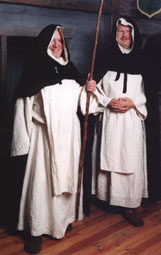Meet the Middle Ages
BackConvents, Hospices and Schools in Kalmar Town

There was a black-friar´s convent near the Castle of Kalmar. It was founded in 1243. The convent was rather like a monastery, with lots of buildings and a large church – Vårfrukyrkan (the Church of our Lady). The convent was more open than a monastery. Visitors from the country-side could spend the night there.
The friars were called black-friars because they wore black habits. They were often preaching in the country-side. They travelled on foot through Kalmar County. Not only did they preach – they would also bring the latest news from town. The friars also helped the peasants to write letters or documents, such as deeds or wills.
There was a nunnery belonging to the Dominican order just outside the town wall. It was founded by Margareta Gustafsdotter in 1299. The convent owned a lot of land in Möre. It had 60 farms in various parishes such as Arby, Hagby, Halltorp, Hossmo, Ljungby, Söderåkra, Förlösa, Kalmar, Kläckeberga, Ryssby, Åby and Vissefjärda. On Öland the convent owned 25 or so farms and in Handbörd and Stranda ten or so farms. The convent employed bailiffs to manage the farms and to collect taxes. In 1379 the convent received a huge donation with lots of property in the north-eastern part of the parish of Vissefjärda.
Just outside Västerport, where Vasaskolan lies today, there was a hospice. It was built during the first part of the 14th century. The hospice was a kind of old peoples ´ home, where the elderly were cared for. The inhabitants paid as much as they were able; rich people paid more and poor people less. The hospice also served as a guest-house for travellers. The church which belonged to the hospice was dedicated to St. George (St. Göran).
The church was in charge of the school which lay just beside the large Nicolaikyrkan (St. Nicholas´ Church). We know that the school existed at the beginning of the 14th century. Boys who later were going into trade or craftsmanship studied here, as well as the sons of the townsmen or the aristocracy. Pupils who wanted to have a career in the Church completed their education at the grammar school in Linköping. Some of these pupils later went to university in Paris.
In 1430 the schoolmaster in Kalmar was called Niclis Thoreri (Nils Thoresson).
Read more about convents, hospices and schools in "Meet the Middle Ages" Community, the Church, Life in Kalmar, Churches and convents and Life in the country-side.